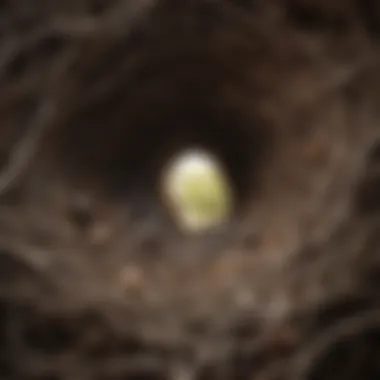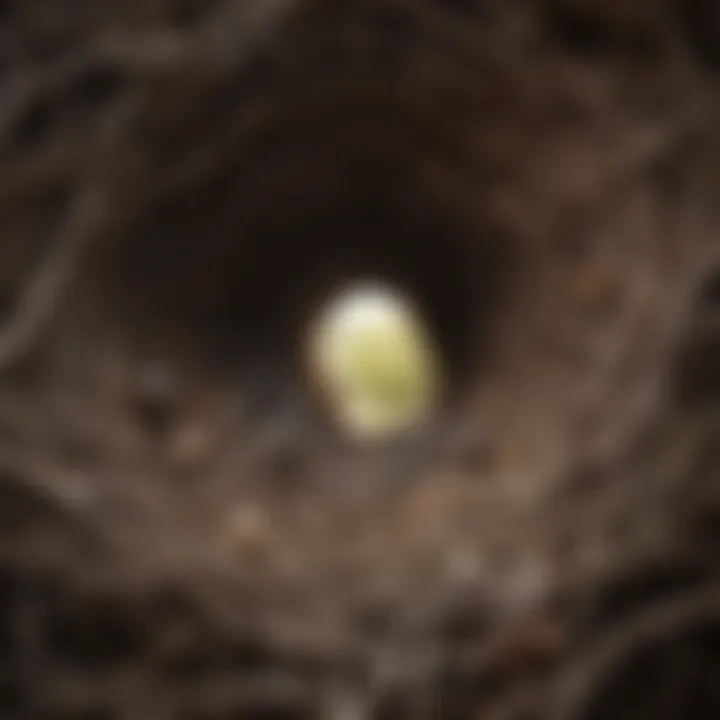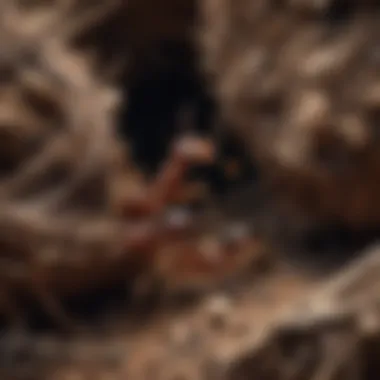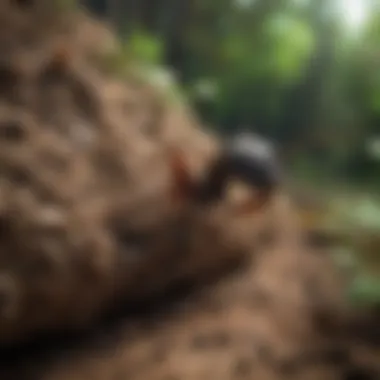Understanding Ants' Nest: Structure and Ecology


Intro
Ants are remarkable insects that often go unnoticed in their habitats. Their nests, however, are vibrant ecosystems in themselves. Understanding these nests reveals not only the structure and function of the ant colonies but also their ecological importance. This article aims to explore the complex framework and social behaviors within ants' nests. We will look deeply into the nesting habits of various species and the vital roles they play in their environments.
Research Overview
Ant nests are intricate constructions that showcase the sophistication of social insect behavior. The study of these nests delves into the architecture that supports the colony's lifestyle, reflecting the species’ adaptations to their particular ecological niches. Each type of nest serves specific functions such as protecting the queen, nurturing the young, and storing food.
Methodological Approaches
Research on ants' nests utilizes several methodologies. Observational studies in natural settings provide insight into ants' behavior and their environmental interactions. Experimental methods include manipulating nest conditions to study responses. Technologies such as 3D imaging help visualize the intricate structures within nests. Data from these methodologies improve our understanding of ant biology and their contributions to ecosystems.
Significance and Implications
The significance of studying ant nests extends beyond mere academic curiosity. Ants contribute to soil health, aerating it through their tunneling activities. Their nests enhance nutrient cycling by breaking down organic materials. Understanding these processes highlights how ants influence biodiversity and ecosystem resilience.
Current Trends in Science
New discoveries are constantly reshaping our understanding of ant nests. This dynamic field integrates various scientific disciplines, from biology to environmental science.
Innovative Techniques and Tools
Recent advancements include the use of molecular tools to study ant genetics and tracing their ecological impacts. These innovations allow researchers to assess the interconnectedness among different ant species and their environments.
Interdisciplinary Connections
The study of ant nests is increasingly recognized in the broader context of ecological health. Collaborations between ecologists, biologists, and even engineers are exploring how ant behavior can inspire solutions to environmental challenges, like improving soil management practices.
Understanding ants' nests provides valuable insights into both ecological dynamics and species adaptation.
These insights not only deepen our appreciation for these small yet mighty insects but also position ants as integral players in maintaining ecosystem balance.
Preamble to Ants' Nest
Ant nests serve as a fundamental aspect of ant ecology. Understanding these structures is crucial for comprehending their role in various ecosystems. Ant nests are not merely homes; they are complex architectures that reflect the social structure of ant colonies. Each type of nest relates closely to the species that builds it and its environment. As we delve into this topic, it becomes clear that nests contribute significantly to ecological stability and biodiversity.
Defining an Ant Nest
An ant nest can be defined as a specialized habitat engineered by ants for the purpose of sheltering their colony. These nests vary widely among species, showcasing distinct structures and functionalities. Some ant species create extensive underground tunnels, while others build mounds or reside within decaying wood. The design and location of an ant nest can indicate numerous aspects of the species’ behavior, ecological needs, and evolutionary adaptations. Nests are not just homes; they are multifunctional environments that support the complex social life of ants.
Purpose of Ant Nests
The primary purposes of ant nests include protection, reproduction, and the management of food resources. First, nests provide a safe haven from predators and harsh environmental conditions. Second, they serve as sites for raising young ants. Third, they help in the storage of food gathered by workers, ensuring the colony's survival during scarce times. Nests also play a role in regulating the internal climate, maintaining optimal conditions for growth and development. Each of these functions emphasizes the importance of nests in the overall survival strategy of ant colonies.
"Ant nests embody the intricate relationship between the species and its environment, revealing much about their adaptations and ecological importance."
In summary, recognizing the significance of ant nests goes beyond basic observation. It opens a window into the intricate world of ants, offering insights into their behaviors and the ecosystems they inhabit.
Types of Ant Nests
Ant nests represent an intricate aspect of ant biology and ecology. They offer insights into the adaptability and survival strategies of various ant species. This section delves into the critical structures that different ants build, highlighting the function and significance of each type. Understanding these nests aids in grasping the complex social systems and ecological roles ants play. By categorizing the nests based on their location and longevity, we can appreciate the diversity in ant behavior and their adaptability to environmental challenges.
Underground Nests
Underground nests are among the most common types of ant habitats. These nests serve multiple purposes in the life of an ant colony. The underground environment provides stability and protection against extreme weather conditions and predators. Typically, these nests feature complex tunnel systems that enable efficient movement and communication within the colony.
The construction of underground nests often involves soil, sand, or gravel, which ants excavate and move away from the nest to create space. Notably, some ant species, such as the Leafcutter Ant, create extensive chambers for storing food. The intricate design allows for proper ventilation and temperature control, thus ensuring that the colony's needs are met year-round.
Key benefits of underground nests include:
- Protection from external threats, ensuring the queen's safety and the continual reproduction of the colony.
- Moisture regulation, which is crucial for larvae and brood development.
- Microclimate control, providing an optimal environment for various life stages of ants.
Above-ground Nests
Above-ground nests represent another diverse category of ant habitats. These structures can be found in trees, shrubs, and even man-made structures. They present unique advantages, especially in terms of resource access. By positioning their nests above ground, ants can easily forage for food such as nectar and insects, improving their overall efficiency.
Materials for these nests often vary greatly. Many species utilize leaves, twigs, and even mud to construct their homes. The Weaver Ant builds impressive nests by weaving leaves together using silk produced from their larvae, showcasing remarkable engineering abilities. Furthermore, the elevated placement of these nests reduces the risk of disturbance from ground-dwelling predators.


The key features of above-ground nests include:
- Elevation, which helps in avoiding certain predators and enhances foraging efficiency.
- Accessibility of food sources, facilitating a varied diet and improving the colony's nutrition.
- Different structural designs that can resist harsh weather, highlighting the adaptability of various ant species.
Ephemeral Nests
Ephemeral nests, or temporary nests, are unique in that they are not meant for long-term habitation. Certain ant species, such as the Red Imported Fire Ant, construct these types of nests for short periods, especially during a foraging phase. These nests may only last a few days or weeks, depending on environmental conditions and the needs of the colony.
The primary purpose of ephemeral nests is to provide shelter while ants forage for food. The materials used for these nests are often lightweight and readily available. In places where resources are abundant, these nests allow ants to take advantage of temporary conditions, optimizing survival rates.
Typically, ephemeral nests have:
- Low structural investment, allowing for quick construction and relocation.
- Flexibility, enabling colonies to rapidly adapt to changing environments or threats.
- Enhanced foraging range, which is vital for species that need to exploit fluctuating food resources.
Ant nests, whether underground, above-ground, or ephemeral, serve as essential structures in their ecosystems. They demonstrate how various ant species adapt their nesting strategies to benefit from their respective environments. Understanding these types leads to greater insight into the ecological role ants play in supporting the biodiversity and health of their habitats.
Nesting Material and Construction
The construction of nests is a crucial aspect of ant biology. It not only reflects the adaptability of ants to various environments but also showcases the complex social structures within their colonies. The materials chosen for nest building are of great importance. Natural materials provide shelter and protection from predators and environmental factors. They also serve to regulate the internal climate of the nest, which is essential for the brood development. By understanding the materials and techniques used in construction, we gain insight into the ecological role of ant nests.
Natural Materials Used
Ants utilize a variety of natural materials for nest construction. These materials can differ significantly based on species and habitat. Some common materials include:
- Soil: Many species, like Formica and Lasius, primarily use soil to excavate their nests underground. The composition of the soil affects its stability and how well it can retain moisture.
- Plant matter: Leaf litter, twigs, and even decaying wood are often incorporated into nests, especially in species like Atta, which create leaf-cutting nests. This organic material provides insulation and improves moisture retention.
- Resin and wax: Certain species, such as Camponotus, use plant resins to reinforce structures and build protective barriers against pests.
These materials are chosen not just for their availability but also for their functional properties. Natural materials help ants maintain the requisite micro-climate necessary for brood development.
Construction Techniques
The construction techniques employed by ants demonstrate remarkable coordination and division of labor within the colony. Building a nest involves several steps:
- Excavation: Many species begin by breaking down the soil or organic matter to create chambers and tunnels. This activity can involve multiple workers, each contributing to the excavation process.
- Material Transport: Workers transport materials back to the nest site. They often rely on pheromones to communicate the best routes and to signal to others about resource availability.
- Assembly: The arrangement of materials is meticulous. Ants may use their mandibles to shape and mold materials, ensuring structural integrity.
- Modifications: Nests are not static. Ants continually modify nests in response to environmental changes. This might involve expanding chambers, reinforcing walls, or even relocating parts of the nest.
"The ability of ants to adapt their nesting techniques is key to their survival in diverse environments."
The construction of ant nests is a reflection of the species' biology and adaptability. Their use of materials and techniques helps ensure the longevity and efficiency of their colonies, playing a significant role in their ecological success.
Social Structure of Ant Colonies
The social structure of ant colonies is a fundamental component of their success as a species. Ants demonstrate a complex organization within their nests that allows for efficiency and survival. Understanding this structure enhances our grasp of the cooperation and roles within these communities.
The hierarchical organization found in ant colonies is particularly noteworthy. This usually involves a queen, workers, and drones, each with distinct responsibilities. This division of labor leads to improved task management, which is vital for the colony's productivity and sustainability. In focusing on these roles, one can appreciate how social interactions and duties contribute to the colony’s overall functioning.
Roles within the Colony
Within an ant colony, the roles are carefully determined to meet the needs of the community. The queen is typically the reproductive figure, responsible for laying eggs. Her primary function is to ensure the growth of the colony. She may live for several years, constantly producing offspring.
Workers, on the other hand, take on a multitude of tasks. Their responsibilities include:
- Foraging for Food: Workers gather resources necessary for the survival of the colony.
- Nurturing Young: They care for the larvae and ensure they grow to maturity.
- Nest Maintenance: They keep the nest clean and expand it as needed, ensuring a healthy environment.
- Defense: Workers also protect the colony from threats and intruders.
Drones exist solely for reproduction. After mating with the queen, their role typically ends since they do not perform any functions related to the upkeep of the colony. This clear delineation of roles maximizes efficiency and survival chances.
Communication Among Ants
Communication is critical in ant societies. Ants primarily communicate through pheromones, which are chemical signals that convey information about food, danger, or other environmental factors.
For example, when a forager discovers food, it releases a trail pheromone back to the nest. Other ants follow this scent, leading them to the food source. This behavior exemplifies the cooperative nature of ant societies, where information sharing is vital for the colony's success.
Ants also use tactile signals, such as touching each other with their antennae. This form of communication is important during the processes of nest construction and maintenance, as well as for the coordination of tasks among workers.
In summary, understanding the social structure of ant colonies is crucial for recognizing the complexities of ant behavior. The roles within the colony and the methods of communication illustrate how ants operate as a cohesive unit, ensuring their survival and ecological importance.
"Ants demonstrate a remarkable ability to work together, driven by a clear structure and communication, adapting well to their environments."
The study of these interactions is not just relevant to biology but also to fields such as ecology and social psychology, where these intricate behaviors can serve as analogs for human social systems.
Ecological Impact of Ant Nests


The ecological impact of ant nests cannot be overstated. Ants, as social insects, play a crucial role in their environments through their nesting behaviors. Understanding their impact highlights the intricate relationships these organisms have with the ecosystems they inhabit. They contribute to soil health, nutrient cycling, and overall biodiversity, providing benefits that extend far beyond their immediate communities.
Soil Aeration and Health
Ant nests significantly influence soil aeration. The construction of tunnels and chambers creates a network of voids within the soil, allowing air and water to penetrate. This process is essential for maintaining healthy soil structure and promoting biological activity. When soil is compacted, roots struggle to access oxygen and water, hampering plant growth. Ant activities mitigate such compaction, making it easier for roots to thrive.
Additionally, the movement of ants helps in redistributing soil particles. As ants excavate and transport materials, they help to mix organic matter with mineral soil. This mixing is vital for creating nutrient-rich topsoil. Enhanced soil structure not only benefits plants but also promotes the proliferation of beneficial microorganisms crucial for soil fertility.
Nutrient Cycling
Ants are instrumental in nutrient cycling. They feed on various organic materials, including dead insects and plant debris. This feeding behavior accelerates the decomposition process. As ants break down organic matter, they release nutrients back into the soil, making them available for plant uptake.
Moreover, ants engage in symbiotic relationships with fungi. Leafcutter ants, for example, gather leaves to cultivate specific fungal gardens. The fungi, in turn, serve as a primary food source for the colony. This mutualistic relationship showcases another dimension of nutrient cycling facilitated by ants. The breakdown of plant material through fungal action increases the nutrient availability in the soil.
Ants also contribute to nutrient cycling by aerating the soil, which improves the conditions for microbial activity. Effective microbial functioning is crucial for the breakdown and transformation of organic matter into forms that plants can use.
"Ants are not just insects; they are environmental engineers that shape the ecosystems they inhabit, facilitating soil health and nutrient availability."
In summary, the ecological impact of ant nests is multifaceted. Through their tunnel networks, ants enhance soil aeration and health, promote nutrient cycling, and foster healthy ecosystems that support a diverse range of species. Recognizing these contributions is essential in appreciating the role ants play in maintaining ecological balance.
Ant Nest Architecture
Ant nest architecture plays a vital role in understanding the behavior and ecology of ants. The design and structure of nests influence how ants interact with their environment. Factors like the availability of resources, climate conditions, and social organization can dictate the architectural choices of different ant species. A well-structured nest can enhance survival, improve foraging efficiency, and support large populations.
Layering and Compartmentalization
Layering and compartmentalization are key features in the architecture of ant nests. Many ant species create multi-layered structures that provide various functionalities. For example, different layers may serve distinct purposes like nurseries for young ants, storage areas for food, or chambers for resting. This division of space helps in managing the colony's activities efficiently.
Each layer is often mud, leaves, or even secreted substances, adding complexity to the internal environment. Such compartments can also help in protecting the colony from predators. By segregating different activities, ants can reduce risks associated with external threats, ensuring the safety of vulnerable members within the nest.
The presence of distinct layers within the nest allows ants to dedicate space for various activities, thus promoting colony productivity.
In addition to efficiency, the design is also adaptive. Some ants can alter their architecture in response to environmental changes. For instance, during heavy rainfall, ants may reinforce the layers to prevent flooding and protect their young populations.
Temperature Regulation
Temperature regulation is a critical aspect of ant nest architecture. The structure's design allows for better control of internal temperatures, which is essential for the colony's health and the development of brood. Ants have developed multiple strategies to maintain a stable climate within their nests.
One method involves insulation, where the materials used in the construction can help regulate temperature. For example, materials such as soil or plant debris can trap air within the walls, providing insulation against extreme external temperatures. This lining keeps the internal environment conducive to the growth of larvae and the comfort of adult ants.
Moreover, ants actively engage in behaviors to assist in temperature regulation. Many species will modify entrance sizes, venting to increase airflow on hot days, or even actively moving brood to cooler areas during heat spells. Similarly, during colder months, they can cluster together to conserve heat.
In summary, both layering and temperature regulation are essential components of ant nest architecture. They serve not only pragmatic functions but also enhance the overall resilience of the colony, ensuring that ants can thrive in their habitats. This intricate design exemplifies the complexity and adaptability of these social insects.
Ant Predator-Prey Interactions
Understanding the interactions between ants and their predators provides insight into the ecological roles of these insects. Ant colonies, with their complex social structures, are pivotal not only in their environments but also within the food web. The delicate balance between ants and their natural predators can influence population dynamics and biodiversity. The significance of these interactions extends beyond mere survival; it includes aspects such as behavioral adaptations and community structures.
Natural Predators of Ants
Ants are prey for a variety of organisms, which can be divided into several categories:
- Invertebrates: Many small invertebrates, such as spiders, beetles, and certain wasps, actively hunt ants. They may enter the nests or ambush foragers outside.
- Vertebrates: Birds and small mammals are natural predators of ants. Some birds are known to specifically target ant trails when hunting for food.
- Larger arthropods: Certain predatory ants, such as army ants, can consume other smaller ant species and disrupt their colonies.
These predators exhibit various strategies to capture ants effectively. They may lay traps, employ stealth, or utilize loud calls to break the defensive lines of ant colonies. The presence of these predators pressures ant populations, impacting their foraging and nesting behaviors.
Defensive Behaviors
Ants have evolved several defensive behaviors to protect themselves from predation:
- Chemical Defense: Many ant species use formic acid or venom as a defensive mechanism. This chemical can deter predators and can be especially effective in group defense scenarios.
- Swarming: When threatened, ants often swarm around a predator in a coordinated effort to provide collective defense. This behavior can confuse or deter the predator.
- Physical Barriers: Some species construct their nests with structural features that are difficult for predators to penetrate. For example, a highly compacted nest can obscure entrances and corridors from larger threats.
"Ants employ both individual and collective strategies to mitigate risks posed by their natural predators, showcasing the complexity of their social behavior."
In essence, the interactions between ants and their predators highlight the ongoing evolutionary arms race. Each ant species' response to predation varies based on environmental pressures, which shapes their survival and reproductive strategies. Understanding these dynamics aids researchers and ecologists in assessing the health of ecosystems, as shifts in predator-prey relationships can lead to broader ecological consequences.
Adaptations in Nesting Habits


The study of adaptations in nesting habits among ants is critical for understanding how these insects thrive in various environments. Each ant species demonstrates unique nesting strategies that are closely tied to their ecological niche and social structure. Adaptations are not merely survival tactics but enhance the functionality and resilience of ant colonies.
Species-Specific Strategies
Ant species have evolved diverse strategies to optimize their nesting habits. These strategies often reflect the specific ecological context in which the species operates. For example, leafcutter ants, such as Atta and Acromyrmex, create nests that enable them to farm fungi, which is their primary food source. They have developed intricate systems to cultivate and maintain their fungal gardens within their nests, making their need for specific nesting materials essential.
On the other hand, fire ants, like Solenopsis invicta, construct mounds that provide good drainage and temperature regulation. Their nests can adapt quickly to environmental changes, providing an advantage for their survival. Each species emphasizes different aspects of construction and design based on their ecological roles.
"Adaptations in nesting strategies reflect the dynamic interplay between species and their environments."
Response to Environmental Changes
Ants demonstrate remarkable adaptability in their nesting habits, responding to environmental fluctuations to ensure their survival. Factors such as temperature, humidity, and predation threats influence the structural features of nests. For instance, during dry seasons, some ants will dig deeper into the soil to access moisture, while during wet seasons, they may build elevations to prevent flooding.
Additionally, the availability of resources can dictate nesting behavior. In urban areas, ants frequently adapt their nesting habits to exploit human-created structures. They may establish colonies within buildings or landscaping, taking advantage of the shelter and resources available in these environments. This adaptability not only provides a practical advantage but showcases the resilience inherent in ant populations.
Human Interaction with Ant Nests
Understanding the human interaction with ant nests is crucial for grasping the broader ecological context in which these species operate. Humans often alter environments that are home to ants. This interaction can significantly influence the survival and behavior of ant populations, and conversely, ants can affect human activities, particularly in urban settings. Examining these relationships highlights the necessity for sustainable practices and conservation efforts.
Ants in Urban Settings
Ants thrive in urban environments, often creating nests in gardens, parks, and even inside buildings. In these areas, ants can contribute positively and negatively. For example, they aerate the soil and help in the decomposition process through their activities. However, some species, like the Argentine ant, can become invasive and disrupt local ecosystems.
The presence of ants in urban settings often leads to conflict. Homeowners may view them as pests if they invade living spaces, which can prompt the use of pesticides. This not only harms the ant populations but can also disrupt the delicate balance of the urban ecosystem, affecting other organisms that interact with ants.
To manage ant populations humanely, individuals can consider non-toxic pest control methods. For instance, diatomaceous earth is an eco-friendly option. This offers both an effective solution and a means to preserve the natural role of ants in the environment.
Conservation Considerations
Conservation efforts should recognize the ecological contributions of ants. These insects play significant roles in nutrient cycling, seed dispersal, and soil health. Protecting their habitats from urban sprawl and pollution is essential. Furthermore, educational programs targeting urban residents can raise awareness about the ecological value of ants. Understanding their behavior and ecology can foster a sense of coexistence rather than conflict.
Conservation organizations might focus on creating preserves that support both native ant species and their natural habitats. This will ensure that ecosystems maintain their balance, and that the positive aspects of ant populations are acknowledged.
Protecting ant habitats is crucial not just for the ants themselves but for the entire ecosystem.
In summary, human interaction with ant nests can have a profound impact on both ants and our ecosystems. By adopting sustainable practices and promoting awareness, we can foster a harmonious relationship with these invaluable insects.
Research Trends in Ant Nest Studies
As research around ants advances, the study of their nests garners increasing attention. This significance comes from understanding how ants interact with their environment and adapt to various challenges. Ant nests serve as complex microhabitats that reflect the ecological and social dynamics of each colony. By studying the structure and function of these nests, researchers unearth insights into both ant behavior and broader ecological phenomena.
Recent Findings
Recent studies have revealed astounding details about the architectural prowess of ants. For example, scientists have explored the various nesting strategies employed by different species, shedding light on how these structures optimize survival and reproduction.
- Some findings indicate that certain ants, like the Leafcutter ants, engage in mutualistic relationships with fungi, using their nests to cultivate these organisms. This type of behavior illustrates innovative use of nesting materials that enhance nutrient availability.
- In terms of structure, ongoing research has shown that ant nests can maintain a regulated internal climate. Researchers have found that some nests, like those created by the desert-dwelling ant, Solenopsis, are particularly adept at temperature regulation. Such adaptations demonstrate the evolutionary pressures influencing nesting behaviors.
- Furthermore, studies have indicated a surprising range of nest designs, from the simple mounds of field ants to intricate underground networks found in species like Formica. This variance highlights the diversity in ecological niches and resource availability across environments.
"Understanding this diversity is crucial for assessing ant roles in ecosystems and their responses to environmental stressors."
Future Directions
Looking ahead, several promising avenues in ant nest research invite exploration. Understanding the impact of climate change on ant nest structures is one priority. As temperatures rise, adaptations in nesting habits may become more pronounced, potentially leading to changes in community dynamics.
- Another focus should be on technological advancements. The use of imaging technologies, such as 3D scanning, could provide new insights into nest architecture without invasive methods. Researchers could visualize and analyze nest complexity and species variations in unprecedented detail.
- Emphasis should also be placed on anthropogenic effects. Investigating how urbanization and habitat destruction alter ant nesting behavior will contribute to conservation efforts. This perspective ties in with the understanding of biodiversity and the ecological roles that ants fill.
- Finally, interdisciplinary approaches that involve education, ecology, and even urban planning could help refine methods to protect ant habitats. Researchers would benefit from connecting insights from various fields to forge a comprehensive understanding of these intricate ecosystems.
In summary, the field of ant nest studies is evolving rapidly. Every discovery not only enhances our comprehension of these remarkable insects but also underscores their importance within the broader context of ecological health.
The End
The conclusion of this article serves as a crucial element in encapsulating the findings and insights surrounding ants' nests. Understanding the complexities of their structure and function highlights not only the fascinating social dynamics within ant colonies but also their significant roles in ecosystems.
Summary of Key Insights
This article detailed various aspects regarding ants' nests. Some of the critical points included the diversity of nesting types, the materials ants utilize for construction, and their intricate social behaviors. The role of ant nests in ecological systems was also emphasized, showing how they aid in soil aeration and nutrient cycling. Additionally, the article discussed how different ant species adapt their nesting habits in response to environmental changes.
Key takeaways include:
- Ants construct various types of nests, each suited to their specific ecological niche.
- Nests contribute positively to soil health, promoting biodiversity.
- The social structure within ant colonies is a testament to their complex communication and organization skills.
Significance of Ant Nests
The importance of ant nests lies in their multifaceted contributions to the environment. They can enhance soil structure, improve nutrient availability, and support a range of other organisms. Ants are often known as ecosystem engineers; their nests create habitats for other species and influence plant communities. The interconnectedness of ants and their environment showcases their ecological significance. Understanding their nesting behaviors offers insights into broader ecological patterns, emphasizing the necessity of conserving these communities.
In summary, recognizing the role of ants and their nests not only enriches our knowledge about biodiversity but also instills a sense of responsibility for environmental stewardship. Their presence in various ecosystems serves as a vital indicator of ecological health.



